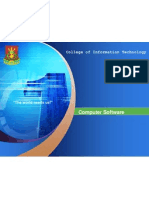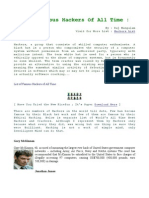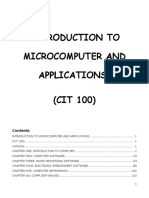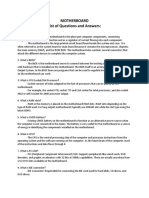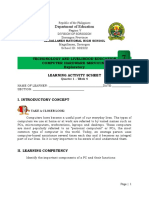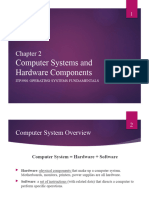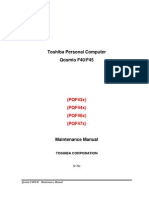Introduction To Computer Technology
Uploaded by
Hanz Dela CruzIntroduction To Computer Technology
Uploaded by
Hanz Dela CruzINTRODUCTION TO COMPUTER TECHNOLOGY
This unit will introduce the learner to basic hardware and software terminology and
features. The learner will learn the proper care and the hardware setup of a basic home
computer. The learner will become familiar with software purchasing and the minimum
requirements of the computer in regards to software.
I. Computer Memory
Lets look at computer memory first. The function of storage in a computer comes in many
different sizes, types and shapes. However there are two basic categories: short-term memory
and long-term memory. A typical computer contains numerous types of memory including RAM,
ROM, virtual, cache, and various long-term storage devices. Each type of computer memory
serves a specific function and purpose.
Computer memory is measured in bytes. A single byte is made up of a series of 1's and 0's
normally traveling in pairs of eight. These eight 0's and 1's are the way the computer
communicates and stores information. With each keystroke or character a byte of memory is
used.
Bits & Bytes
8 bits = 1 byte
1000 bytes = 1 kilobyte
1000 kilobytes = 1 megabyte
1000 megabytes = 1 gigabyte
1000 gigabytes = 1 terabyte
II. ROM & RAM
ROM, or read-only memory is permanent, long-term, nonvolatile memory. Nonvolatile means it
does not disappear when the computer is shut off. It also cannot be erased or changed in
anyway. However there are types of ROM called PROM that can be altered. The P stands for
programmable. ROM's purpose is to store the basic input/output system (BIOS) that controls the
start-up, or boot process.
RAM, or random-access memory unlike ROM works only when the computer is turned on. This
memory is vital to the computer because it controls the moment by moment processes of the
computer. The first thing that goes into RAM is the OS (operating system) which includes
Windows 98, Windows 2000 or Windows XP. Next for the RAM might be a game, or the Internet
browser, or some type of software that you want to use.
RAM stick
Multitasking has put more demand on RAM in the past few years. Multitasking is the ability to run
more than one program at the same time. For instance, many people like to run a web browser
along with their word processing software. This means you need lots of RAM to hold both
programs.
III. Storage Devices
Floppy disk Hard disk drive
A round plastic surface that is coated with A stack of round metal platters called disks
magnetic film. They come in 3.5 inch size. encased in a metal air tight shell. They commonly
They hold about 720 kB to 1440 kB of range in sizes from 20 to 120 gigabytes
information. They typically are used to (1000MB=1GB). The hard drive's function is to
install new software, save, share, and/or store all the files, and software the computer will
copy files. Floppy drives are given letters. ever use. Any file or software program used by
Commonly the floppy is A. If there is a RAM most likely will come from this drive. The
second floppy drive it would be drive B. hard drive is commonly lettered as the C drive.
CD-ROM (Compact disk, read-only DVD-ROM (digital video disk, read-only
memory) memory)
CD's function much like hard drive in that DVD's are similar to CD in that they are written
they store large amounts of memory. What and read by laser. Hard drives use magnetic
separates them is their mobility and optical currents store data. However CD's and DVD's use
storage technology. Their storage capacity light (laser) to write and read data on a disk.
is also very limited compared to hard These long and short pits are then stored or
drives. The can only hold up to etched on the surface of the disk. They can only
approximately 650 MB of information. The be read by laser technology. The new DVD
other big difference is that you have to have technology increased the amount of memory a
a special drive called a CD writer or burner regular CD can hold. DVD's can range in sizes
to write to CD's. Otherwise they can only be from 4.34GB (1000MB=1GB) to 7.95GB.
read.
IV. Input and Output Devices
A. Input
One of the best features of a computer is the ability to give the computer commands and feed it
information. Without an input device this would not be possible. Input devices can be built into the
computer or it can be connected to the computer by a cable. The most common input device is
the keyboard. There are lots of others such as: mice, trackballs, touch pads, touch screens, pens,
joy sticks, scanners, bar code readers, video and digital cameras, and microphones. In addition,
storage devices such as disk drives can serve as input devices.
Digital Video
Mouse Keyboard Touch Screen Card Reader
Camera
B. Output
Input is important but equally important is the ability to read what the computer is doing. The
computer output devices are used to serve the user. The most common output device is the
monitor, or screen. However, most computers come with speakers and a printer which are
excellent output devices. Storage devices such as disk drives and diskettes also serve as output
devices when it is necessary to write new or updated data files to disk or tape.
Zip disk Floppy disk Monitor Fax Machine Printer
V. CPU
The brains of the computer is the microprocessor. The microprocessor is often referred to as the
CPU (Central Processing Unit). The microprocessor is a chip the size of a postage stamp. The
processor is the one part of the computer that is most important to the computer. The
microprocessor controls how data is sorted and directs the flow of data.
Task:
A. Define the following terms in your own words.
1. Input Device
2. Output Device
3. Software
4. Hardware
5. Storage Device
6. Memory
7. Multi-tasking
B. Answer the following questions.
1. How many bytes does one character or keystroke take up? (If you type the letter
"S" how much memory does it take up?)
2. How many bytes are in a megabyte?
3. What type of memory is nonvolatile?
4. RAM would be an example of _____________________________
5. The monitor would be an example of _____________________
6. Give at least two example of the following (no you cannot use the examples listed up above):
a) Storage device:
b) Hardware:
c) Input devices:
You might also like
- Hardware, Software and Networkings: Machine Cycle Drama ScriptNo ratings yetHardware, Software and Networkings: Machine Cycle Drama Script4 pages
- ICT 1101 - PC Hardware Assembly 02 Fall 2021No ratings yetICT 1101 - PC Hardware Assembly 02 Fall 202124 pages
- Study and Identification of PeripheralsNo ratings yetStudy and Identification of Peripherals21 pages
- 23 Computer Application Commerce Unit-02No ratings yet23 Computer Application Commerce Unit-0242 pages
- Computer Software: College of Information TechnologyNo ratings yetComputer Software: College of Information Technology18 pages
- Computer Maintenance and Repair: PrecisionNo ratings yetComputer Maintenance and Repair: Precision22 pages
- CPSC 105 PC Security and Privacy: How Computers WorkNo ratings yetCPSC 105 PC Security and Privacy: How Computers Work74 pages
- Administare-Netwrok-and-Hardware Peripheral-DevicesNo ratings yetAdministare-Netwrok-and-Hardware Peripheral-Devices38 pages
- Basic-Configuration-and-Installation-of-Operating-System FinalNo ratings yetBasic-Configuration-and-Installation-of-Operating-System Final43 pages
- Motherboard Components Labeled - Motherboard Parts and Functions PDF80% (5)Motherboard Components Labeled - Motherboard Parts and Functions PDF5 pages
- Lab Manual of Computer Maintenance and Troubleshooting (C301-3350701) Semester - 5No ratings yetLab Manual of Computer Maintenance and Troubleshooting (C301-3350701) Semester - 559 pages
- Computer Appreciation and Its ApplicatioNo ratings yetComputer Appreciation and Its Applicatio15 pages
- Unit 1 Computer System (2) (1) - 1629266582No ratings yetUnit 1 Computer System (2) (1) - 162926658261 pages
- Chapter 3 Data Representation and Computer ArithmeticNo ratings yetChapter 3 Data Representation and Computer Arithmetic13 pages
- Lesson 4 Personal Computer Hardware Components (Internal Devices)No ratings yetLesson 4 Personal Computer Hardware Components (Internal Devices)22 pages
- 01 Information Processing Cycle 1201113124804673 3No ratings yet01 Information Processing Cycle 1201113124804673 316 pages
- 14 Common Hard Drive Problems and Solutions UltimateNo ratings yet14 Common Hard Drive Problems and Solutions Ultimate1 page
- Communication Hardware & Communication SoftwareNo ratings yetCommunication Hardware & Communication Software16 pages
- Salahaddin University College of Engineering Geomatics DepartmentNo ratings yetSalahaddin University College of Engineering Geomatics Department6 pages
- CO - FY2016 2018 TVL List of Tools and Equipment With Recipient SchoolsNo ratings yetCO - FY2016 2018 TVL List of Tools and Equipment With Recipient Schools26 pages
- F. Bustamante National High School F. Bustamante National High SchoolNo ratings yetF. Bustamante National High School F. Bustamante National High School1 page
- New Approach For E-Learning Using Web 2.0 Tools OER PerspectiveNo ratings yetNew Approach For E-Learning Using Web 2.0 Tools OER Perspective44 pages
- CHS Module 5 - Diagnose and Troubleshoot Computer Systems100% (7)CHS Module 5 - Diagnose and Troubleshoot Computer Systems54 pages
- Book Borrowing System in Northern Mindanao Colleges Library100% (4)Book Borrowing System in Northern Mindanao Colleges Library32 pages
- Basic Concepts: Heat, Light, or Mechanical Power. in Fact, Thomas Edison Himself Never Thought ElectricNo ratings yetBasic Concepts: Heat, Light, or Mechanical Power. in Fact, Thomas Edison Himself Never Thought Electric10 pages
- 3ds Max Vray Landscape Design Skills Speed Train PDFNo ratings yet3ds Max Vray Landscape Design Skills Speed Train PDF4 pages
- Class Xi IP (065) : Hardware AND Software ConceptsNo ratings yetClass Xi IP (065) : Hardware AND Software Concepts42 pages
- Chapter 3 Exam Style Questions + Exam Style QuestionsNo ratings yetChapter 3 Exam Style Questions + Exam Style Questions4 pages
- What Did He Say - Computer Jargon ExplainedNo ratings yetWhat Did He Say - Computer Jargon Explained30 pages
- Secondary Storage: Sequential and Direct-Access DevicesNo ratings yetSecondary Storage: Sequential and Direct-Access Devices6 pages
- Hardware, Software and Networkings: Machine Cycle Drama ScriptHardware, Software and Networkings: Machine Cycle Drama Script
- Computer Software: College of Information TechnologyComputer Software: College of Information Technology
- CPSC 105 PC Security and Privacy: How Computers WorkCPSC 105 PC Security and Privacy: How Computers Work
- Administare-Netwrok-and-Hardware Peripheral-DevicesAdministare-Netwrok-and-Hardware Peripheral-Devices
- Basic-Configuration-and-Installation-of-Operating-System FinalBasic-Configuration-and-Installation-of-Operating-System Final
- Motherboard Components Labeled - Motherboard Parts and Functions PDFMotherboard Components Labeled - Motherboard Parts and Functions PDF
- Lab Manual of Computer Maintenance and Troubleshooting (C301-3350701) Semester - 5Lab Manual of Computer Maintenance and Troubleshooting (C301-3350701) Semester - 5
- Chapter 3 Data Representation and Computer ArithmeticChapter 3 Data Representation and Computer Arithmetic
- Lesson 4 Personal Computer Hardware Components (Internal Devices)Lesson 4 Personal Computer Hardware Components (Internal Devices)
- 01 Information Processing Cycle 1201113124804673 301 Information Processing Cycle 1201113124804673 3
- 14 Common Hard Drive Problems and Solutions Ultimate14 Common Hard Drive Problems and Solutions Ultimate
- Salahaddin University College of Engineering Geomatics DepartmentSalahaddin University College of Engineering Geomatics Department
- CO - FY2016 2018 TVL List of Tools and Equipment With Recipient SchoolsCO - FY2016 2018 TVL List of Tools and Equipment With Recipient Schools
- F. Bustamante National High School F. Bustamante National High SchoolF. Bustamante National High School F. Bustamante National High School
- New Approach For E-Learning Using Web 2.0 Tools OER PerspectiveNew Approach For E-Learning Using Web 2.0 Tools OER Perspective
- CHS Module 5 - Diagnose and Troubleshoot Computer SystemsCHS Module 5 - Diagnose and Troubleshoot Computer Systems
- Book Borrowing System in Northern Mindanao Colleges LibraryBook Borrowing System in Northern Mindanao Colleges Library
- Basic Concepts: Heat, Light, or Mechanical Power. in Fact, Thomas Edison Himself Never Thought ElectricBasic Concepts: Heat, Light, or Mechanical Power. in Fact, Thomas Edison Himself Never Thought Electric
- 3ds Max Vray Landscape Design Skills Speed Train PDF3ds Max Vray Landscape Design Skills Speed Train PDF
- Class Xi IP (065) : Hardware AND Software ConceptsClass Xi IP (065) : Hardware AND Software Concepts
- Chapter 3 Exam Style Questions + Exam Style QuestionsChapter 3 Exam Style Questions + Exam Style Questions
- Secondary Storage: Sequential and Direct-Access DevicesSecondary Storage: Sequential and Direct-Access Devices













